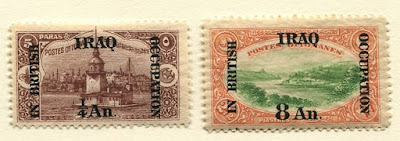Map of Mesopotamia
Bud's Big BlueBud's Observations
Was there ever a nation or stamp
issuing authority called Mesopotamia? Well, no, there was not.
Mesopotamia was/is no more a nation
than, say, the Fertile Crescent was/is a nation, or the Ancient Near East.
Mesopotamia is a historic geographical region -- the area of rich land stretching
between the Tigris and Euphrates rivers
and bound in the northeast by the Zagros Mountains. Over the past several millennia
Mesopotamia has been home for many tribes, river civilizations, city states, empires,
and nations. Today, most of Iraq and some of Turkey and Syria occupy the territory
historically regarded as Mesopotamia.
Why,
then, does Big Blue have a section for Mesopotamia stamps? Why do none of the
stamps meant for this section have “Mesopotamia” inscribed on them? The answers
to these questions are deeply entrenched with the events of World War I and its
aftermath, along with many other puzzlements about Big Blue’s contents.
Iraq Issues, Scott #s N28 and N36,
Indian Currency
Turkish scenes along the Bosporus River that connects the
Black and Aegean seas.
The
telling clue is in the marginal overprint: “In British Occupation.” The British
Army formed the Mesopotamia Expeditionary Force, comprised of the Indian
Expeditionary Force D (IEFD) and Lord Kitchener’s volunteers, known as the 13th (Western) Division. Together, they
intended to end Ottoman control of “Mesopotamia”, provide greater protection
for Britain’s investment in Suez, control rich oil resources and, in the
process, increase popular Muslim support for Britain in India and Iraq.
The
recycled Ottoman stamps reinforce these objectives. They show traditional
Turkish scenes and symbols but now, clearly, under British and Indian control
and authorization.
Mosul Issues with initials of
Indian Expeditionary Force “D”
Scott #s N47-9, Indian currency
After
the war ended, matters became increasingly complicated. The British were to
receive a mandate from the League of Nations to govern Mesopotamia, but it never
got beyond the planning stage. Two questionable plebiscites were organized, but
they also failed to clarify matters. Some British leaders hoped to make the
fertile plains of Mesopotamia a colony of India, a reward for Punjab warriors, but
that also did not come about. An Iraqi revolt ensued in 1920 after which the Anglo-Iraq
Treaty (October 1922) specified that Iraq would eventually become an
independent Kingdom. After yet further disputes, Iraqi independence came in
1931-2.
So, the
overprinted Turkish stamps remained in use until the first definitive stamps of
Iraq were issued in 1923. Scott catalogs and albums place these overprints in a
category labeled “Mesopotamia”, consistent with contemporary British and League
of Nations nomenclature. Stanley Gibbons catalogs, however, list them under
Iraq, consistent with what the region became. Given the entanglements of
post-war Mesopotamia/Iraq, and, given the fact that Iraq did not exist as a proper
state until after the stamps were decommissioned, I think Scott made the better
choice.
The Mesopotamia blog (link below) focuses on the British occupation issues of 1917- 1922, as well as the Mosul issue of 1919. All of the stamps consist of surcharged/overprinted stamps of Turkey. One will find these stamps under "Mesopotamia" in the Scott Classic catalogue. The Stanley Gibbons catalogue files all entries under "Iraq".
For the issues of Iraq proper, from 1923-1938, see the Iraq blog.
Mesopotamia Blog Post & BB Checklist
Page 1
1a
Supplements
Page 1
Comments appreciated!






No comments:
Post a Comment